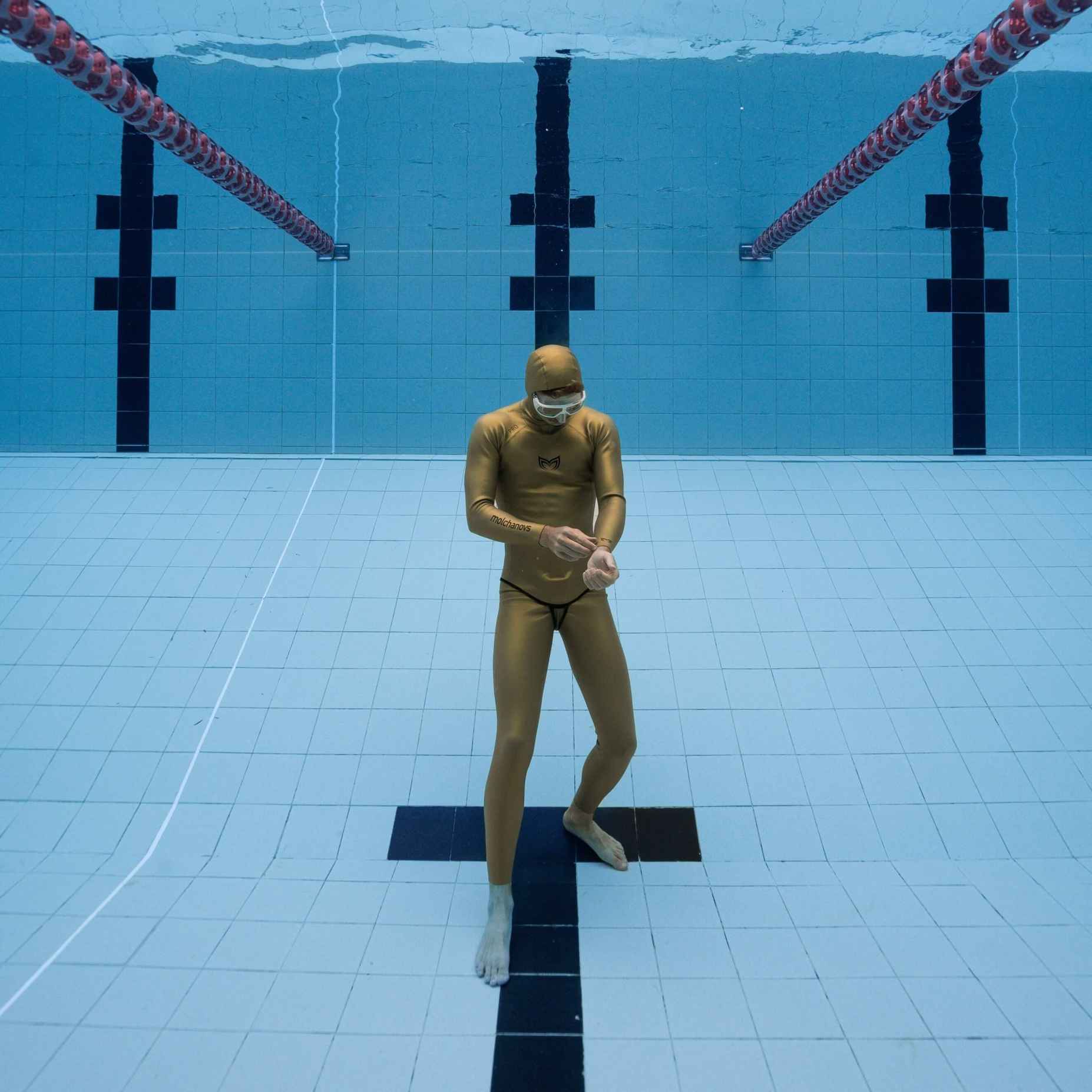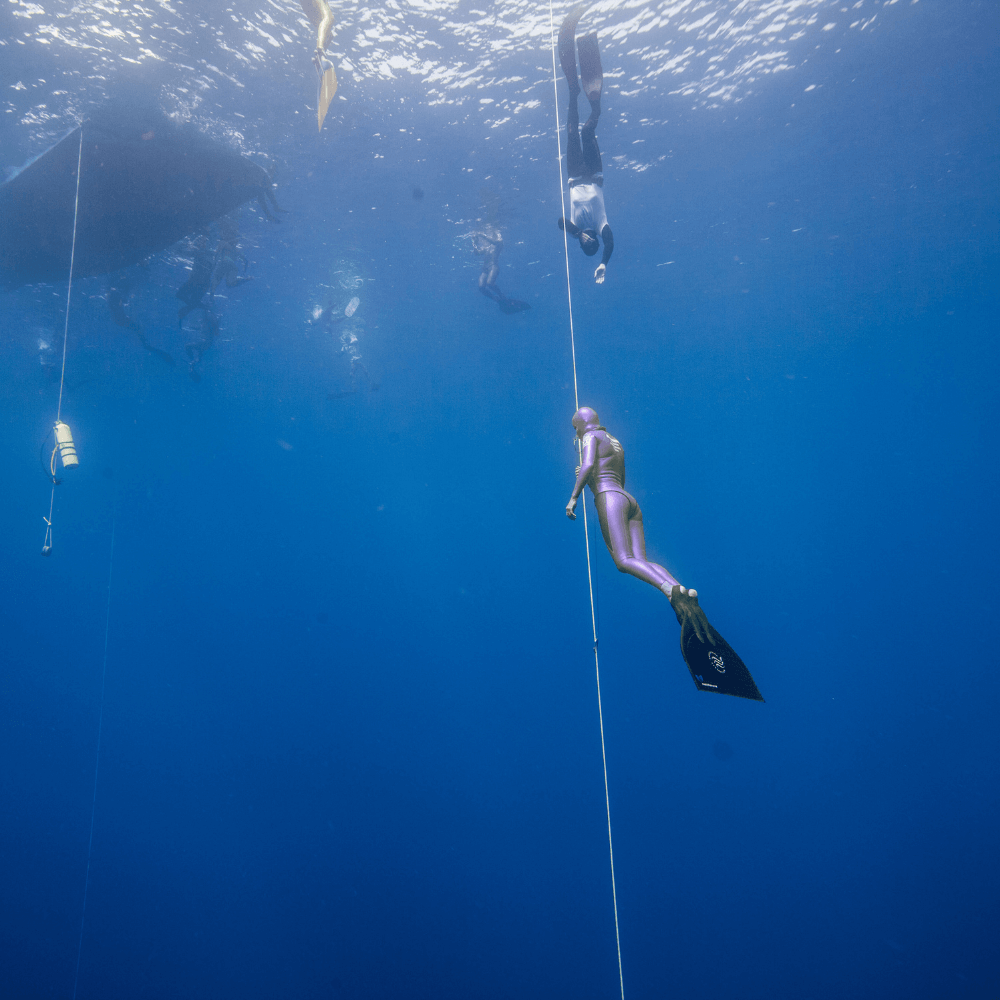장비 관리 지침
최대 성능을 보장하고 장비의 수명을 연장하려면 아래의 관리 지침을 따르세요. 부적절/잘못된 사용 또는 불충분/부적절한 유지보수 및 제품 관리로 인한 장비 결함 또는 손상은 보증 정책을 무효화합니다.
탄소 및 유리섬유 핀
수영장 바닥이나 수영장 벽 등 딱딱한 표면에 칼날을 대고 누르지 마세요.
핀/스를 착용한 상태에서 물에 뛰어들지 마세요 - 이미 물에 들어간 후 핀을 착용하는 것이 좋습니다.
사용 후 담수로 헹굽니다.
직사광선에 보관하지 말고 그늘에 보관하세요.
핀/핀은 뜨겁고 건조하며 밀폐된 장소(예: 직사광선을 받는 차량 내부)에 두지 마세요.
표면에 수평으로 보관하거나 핀 랙에 수직으로 보관합니다.
핀이 마를 때까지 기다렸다가 가방이나 보관함에 넣습니다.
오픈 힐 풋 포켓에 실리콘 그리스를 사용하여 풋 포켓의 수명을 연장하세요.
실리콘 핀
풋포켓과 뒷끈을 날카로운 물체 근처에 두지 마세요.
얼룩이 잘 생기는 천이나 소재 근처에 핀/핀을 두지 마세요(물에 젖으면 염료가 사라집니다).
직사광선에 보관하지 말고 그늘에 보관하세요.
핀/핀은 뜨겁고 건조하며 밀폐된 장소(예: 직사광선을 받는 차량 내부)에 두지 마세요.
사용 후 담수로 헹굽니다.
표면에 수평으로 보관하거나 핀 랙에 수직으로 보관합니다.
핀이 마를 때까지 기다렸다가 가방이나 보관함에 넣습니다.
잠수복
모든 잠수복:
여기에서 잠수복을 입고 벗는 방법을 확인하세요.
잠수할 때마다 잠수복을 직접 담수에 완전히 헹구어야 합니다. 잠수복을 입을 기회가 없다면 바닷물이 담긴 가방에 넣어두세요. 잠수복에 소금물이 마르지 않도록 하고 세탁기로 세탁해서는 안 됩니다.
신선한 물로 헹군 후 잠수복을 공기 건조시킵니다. 햇볕, 화재 근처, 중앙 난방 시스템 근처 또는 의류 건조기에서 잠수복을 말리지 마세요.
햇볕 아래에서 오랫동안 잠수복을 입고 있다면 보호용 천 티셔츠를 입는 것이 좋습니다.
때때로 잠수복 전용 샴푸로 잠수복을 세탁해야 합니다. 지침을 잘 따르세요. 잠수복 전용 탈지제를 사용하여 기름, 기름 및 기타 얼룩을 제거하세요. 잠수복에 석유 제품을 절대 사용하지 마세요.
건조한 잠수복은 서늘하고 건조한 곳에 보관하고 과도한 기간 동안 접지 마세요. 단기 운송을 위해 잠수복을 접는 것은 허용되지만, 그렇지 않은 경우 평평하게 놓거나 잠수복이 펴지지 않는 옷걸이에 걸어두는 것이 좋습니다. 직사광선에 보관하지 마세요.
잠수복이 찢어지면 대부분의 다이빙 센터나 수상 스포츠 매장에서 판매하는 네오프렌 시멘트를 사용하여 수리하세요. 지침을 주의 깊게 따르세요. 매끄러운 피부 솔기를 재봉하지 마세요. 천으로 마감된 표면은 루프 스티치가 가능하지만 반대쪽 표면까지 완전히 스티치하지는 마세요. 잠수복 수리에 대해 궁금한 점이 있으시면 이메일(info@molchanovs.com )로 문의해 주시면 기꺼이 도와드리겠습니다.
PRO 잠수복:
PRO 잠수복 라인에 사용되는 고품질 성능 소재로 인해 잠수복을 착용하고 벗을 때는 더욱 주의해야 합니다. 직사광선 아래에서 장시간 PRO 잠수복을 착용하는 것은 권장하지 않습니다. 장시간 PRO 잠수복을 착용해야 하는 경우 잠수복 위에 보호 천 티셔츠를 착용하여 활공 피부층을 보호하는 것이 좋습니다.
마스크
몰차노프 마스크에는 플라스틱(폴리카보네이트) 렌즈가 포함되어 있으므로 치약으로 '사전 처리'하거나 라이터로 태워서는 안 됩니다. 그렇게 하면 렌즈가 손상됩니다.
마스크가 먼지와 기름에 닿지 않도록 주의하세요.
다이빙 후 마스크를 미지근한 담수에 완전히 담가 헹구고 직사광선이 닿지 않는 곳에서 완전히 건조시킨 후 원래 케이스 안에 보관하세요.
거칠거나 날카로운 물건을 사용하여 마스크 렌즈의 안쪽과 바깥쪽을 문지르지 마세요. 다이빙할 때 렌즈 내부에 김서림 방지 스프레이를 사용하는 것이 좋습니다.
사용하지 않을 때 직사광선에 장시간 노출되지 않도록 주의하세요.
부표
완전히 부풀려진 부표는 직사광선 아래나 뜨거운 차 안에 두지 마세요.
부표 손잡이에 로프를 부착하지 말고 D-링에만 부착합니다.
과도한 인플레이션을 방지하려면 펌프 대신 입으로 부표를 부풀리는 것이 좋습니다.
가방
소금물과 접촉한 후 깨끗한 물로 헹굽니다.
-50°C(-58°F)보다 차갑거나 80°C(176°F)보다 뜨거운 온도에서는 사용하지 마세요.
30°C(86°F) 이하에서 세탁하세요. 말리거나 짜지 마세요. 손세탁을 권장합니다.
화재에 노출되지 마세요.
랜야드
벨크로의 필연적인 약화와 시간이 지남에 따라 전선의 녹이 발생할 수 있으므로 2년마다 랜야드를 교체하는 것이 좋습니다.
얼음이 얼은 조건에서 다이빙할 경우 올바르게 열리지 않으면 캐러바이너 내부의 스프링이 손상될 수 있습니다. 수중에서는 캐러바이너를 정상적으로 열고 닫을 수 있습니다. 물 위에서는 혹독한 대기 온도로 인해 캐러바이너 스프링이 얼었다고 가정하고 열기 전에 다시 물속에 넣어 얼음을 제거하세요.
EQ 트레이너
처음 사용하기 전에 EQ 트레이너 2의 양쪽 부분을 비눗물로 헹구고 소독 스프레이를 뿌립니다. 조립하기 전에 제품이 완전히 건조될 때까지 기다립니다. 새 풍선을 처음 사용하기 전에 헹구고 공기 건조해야 합니다.
각 사용 후 EQ 트레이너 2를 청소하는 것이 좋습니다. 먼저 장치를 분해한 다음 비눗물로 헹구고 소독제 스프레이를 뿌립니다. 재조립하기 전에 장치가 완전히 마를 때까지 기다립니다.
느슨해지고 조이는 과정을 더 부드럽게 하려면 모든 종류의 실리콘으로 나사산을 윤활할 수 있습니다.
딱딱한 표면에 던지거나 떨어뜨리지 마세요.
-40°C(-40°F)보다 차갑거나 50°C(122°F)보다 뜨거운 온도에서는 사용하지 마세요
장시간 극심한 열에 노출되지 마세요.
의류
의류와 수영복은 부드러운 세탁 세제로 손으로 세탁하거나 찬물이나 미지근한 물로 세탁기를 사용하세요.
직물 수축과 변색을 방지하기 위해 그늘에서 공기 건조하는 것이 좋습니다.
다리미질을 하려면 천을 안쪽으로 뒤집거나 누르는 천 아래에 중불 설정을 사용합니다.
수영 모자
사용 후 바로 (염소되지 않은) 담수로 헹굽니다.
수영모 내부와 외부를 직사광선이 닿지 않고 열원으로부터 멀리 떨어진 곳에서 공기 건조한 후 보관하세요.
젖은 수영모는 밀폐된 용기나 가방에 장시간 보관하지 마세요.
직사광선에 장시간 노출되지 않도록 주의하세요.
손톱이 긴 경우 수영모를 착용할 때는 더욱 주의하세요.



